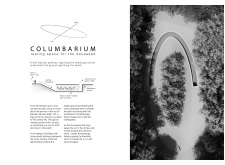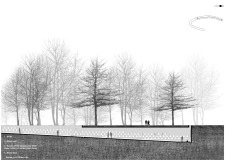5 key facts about this project
From an architectural standpoint, the design embodies key concepts such as fluidity, lightness, and integration with the surroundings. The overall form is characterized by clean lines and a rational layout that emphasizes usability without compromising aesthetic appeal. Strategic openings and transparent materials ensure that natural light permeates interior spaces, fostering an inviting atmosphere conducive to the designated activities within the building. This approach not only enhances the interior experience but also creates a dialogue between the inside and outside, inviting nature into the everyday lives of users.
One of the standout aspects of this project lies in its material selection. The use of concrete for structural components provides longevity and stability, while expansive glass facades facilitate a visual connection to the outdoors and allow for ample daylight. Additionally, wooden elements, whether used in cladding or interior furnishings, add warmth and a tactile quality that contrasts beautifully with more industrial finishes. These choices reflect a balanced consideration for sustainability and aesthetics, a hallmark of contemporary architectural practice.
Outdoor spaces have been meticulously planned to complement the built environment. Landscaped areas offer opportunities for recreation and socialization, seamlessly integrating with pathways that encourage movement through the site. The inclusion of greenery not only enhances the visual appeal but also contributes to the ecological footprint of the building, fostering biodiversity and promoting ecological health.
Sustainability is a key theme that runs throughout the project. The design incorporates innovative solutions such as rainwater management systems, photovoltaic panels, and energy-efficient heating and cooling systems, underscoring a commitment to reducing environmental impact. These strategies not only serve to lower operational costs but also educate and inspire users about the importance of sustainable living practices.
The project distinguishes itself with unique design approaches that challenge conventional architectural norms. For instance, the adoption of biophilic design principles is evident through the strategic placement of natural elements, such as indoor gardens or green walls, promoting mental well-being and connectivity with nature. Additionally, the building may include flexible spaces that adapt to various uses over time, demonstrating a forward-thinking approach that anticipates the evolving needs of its users and the community.
Throughout the building, attention to detail is paramount. The choice of finishes, the arrangement of spaces, and the integration of technology come together to create an environment that is both functional and aesthetically pleasing. These careful considerations enhance the user experience, ensuring that the architecture serves its purpose effectively while being a source of pride for the community.
Interested readers are encouraged to explore the project presentation further, delving into architectural plans, sections, designs, and ideas. By examining these elements, one can gain a more profound understanding of the architectural intentions and the thoughtful integration of functionality and design evident in this project.


























